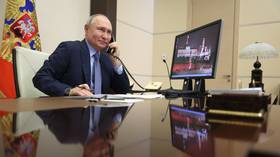‘Don’t let Syrians down’: Top Red Cross official tells RT of despair and destruction in Ghouta
People in Ghouta, Syria are in desperate need of support, lacking access to water, sanitation and healthcare, a top Red Cross official told RT. He said that he was overwhelmed by the scale of destruction he saw.
Dominik Stillhart, the head of operations at International Committee of the Red Cross (ICRC), who just returned from Syria, admitted on RT that he had not seen anything quite as depressing in nearly three decades of humanitarian work. Before joining the ICRC headquarters in Geneva, the top-tier official spent 15 years working in the field in Africa, the Balkans and the Middle East.
I have to say I was completely overwhelmed by the scope of destruction in Eastern Ghouta. I think I’ve never seen anything like this in my 27 years of career with ICRC.
As part of his Syria trip, Stillhart visited Eastern Ghouta, a Damascus suburb that has been only recently liberated by government forces. Ghouta, which once was home to some 3 million people, is now almost a barren wasteland with only 350,000 people living there.
In #EasternGhouta today. I’m simply overwhelmed by the sheer scale of destruction here. And yet people are starting to come back! There is so much to do and people will need support more than ever. #Syriapic.twitter.com/alLpQEX882
— Dominik Stillhart (@DStillhartICRC) October 24, 2018
In the place where I was, nearly 90 percent of infrastructure is completely destroyed. You see the entire neighborhoods destroyed… houses that have become completely unlivable.
Eastern Ghouta has seen intense fighting between Syrian troops and Islamist militants who were holding the strategic area since 2013. Finally, in March of this year, the breakthrough came after the army gained control over the highway connecting Damascus to the rest of the country.
The battle of Eastern Ghouta saw tens of thousands of civilians as well as numerous rebels flee through humanitarian corridors in search of safety. Daily truces came into effect on February 27, as part of the Syrian Army and Russia’s efforts to help civilians – and later militants who laid down their arms – escape the combat zone.
Despite unparalleled destruction and remnants of war, life is returning to Eastern Ghouta, Stillhart noted.
“And that is what I was talking about – people who are back, people who are living there, they can fend for themselves in terms of some the basic needs.”
Food is available from the ICRC and Syrian Arab Red Crescent teams on a daily basis, but is equally crucial that that the returnees can also access water, sanitation and healthcare.
Following over seven years of war, peace has been brought to Homs, Aleppo and Deir-ez-Zor areas thank to local ceasefire agreements reached between the government and militant groups. Idlib is now the last remaining bastions still at the hands of Al-Nusra terrorists and other factions. The Syrian government, along with some major powers, is currently striving to liberate the area without resorting to armed force.
“I am grateful for all efforts that are taking place in the past few months – and possibly will continue – to avoid escalation in Idlib because, as I said, this would result in a very, very serious humanitarian disaster,” Stillhart said.
Asked about a message he would like to send out to international community, Stillhart responded with a simple answer.
My message is very simple: don’t let Syrian people down.
Finishing, Stillhart estimated the Syrian war one of the worst conflicts of our time. “And yet, there doesn’t appear to be a sufficient political convergence to bring this conflict to an end”.
Think your friends would be interested? Share this story!















